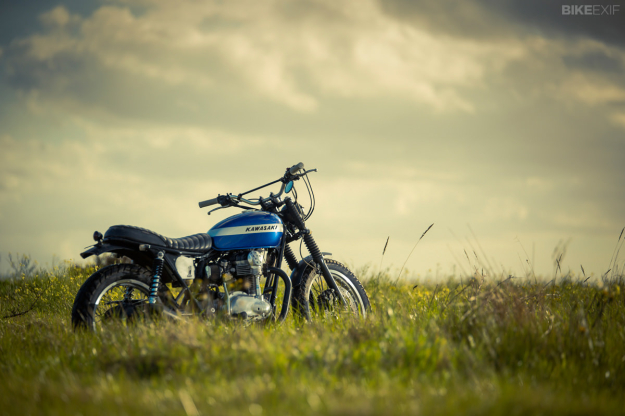
I think it was a Deus Ex Machina tracker that first piqued my interest in the Kawasaki W650. But, down here in Cape Town, South Africa—a country where the W650 was never officially imported—they’re extremely hard to come by.
So when one suddenly came up for sale, I snapped it up without a moment’s hesitation. I had just sold my Husqvarna TE610 (the third dual-sport bike that I’d owned in as many years) and was looking for something completely different.
The W650 fit the bill, and it was paid for the same day I test rode it. The previous owner had fitted a set of ace bars and a Nitroheads seat, bobbed the fenders, removed the airbox and resprayed the tank. It wasn’t long before I installed a set of Husky dirt-bike bars and discovered just how easy-going the twin was on gravel roads.

About a year later I found myself passing through the dusty trails of the Cederberg and Tankwa-Karoo, and over the infamous Ouberg Pass into Sutherland. I’d done that pass before—on my TE610. It was considerably more challenging on the W.
I thought the worst of it was the two cracked exhaust headers that had to be welded in Sutherland, but a strip down of the bike back home revealed a busted battery and box, and a swingarm corroded by battery acid.
I parked it, and thanks to a mix of procrastination and lack of funds, left it for almost a year—eventually deciding to flog it out of pure frustration. As it turns out, you’re never too old to be disciplined by your parents. My mom—herself the proud owner of a Harley-Davidson 883 Sportster—caught wind of this, chastised me, and offered to help fund a full overhaul. It was just the kick in the pants I needed, and the project was underway.
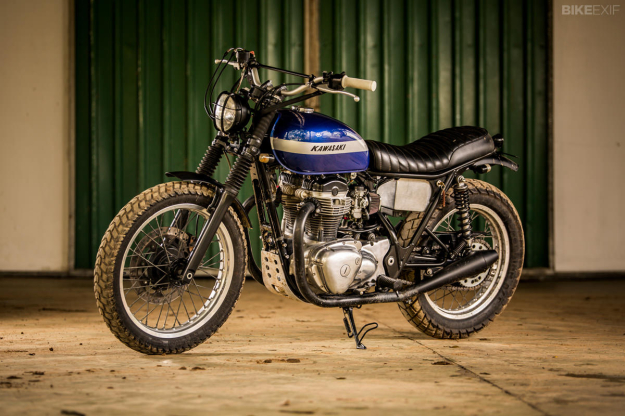
Since I’m better at taking things apart than reassembling them, I commissioned Alex Stoos of Stoos Customs to handle the build. Alex’s forté is brutal and raw Harley-based customs—but he was amped to tackle a Jap bike with a different vibe. I would take the creative lead on the project and source the relevant parts, and Alex would handle the fabrication.
Aesthetically, I knew I wanted to build a scrambler of sorts—one that would be just as at home on city streets as it would exploring fire roads—without falling apart. The idea was to focus on tasteful, well-considered and practical changes. A lot of inspiration was drawn from Café Racer Dreams, Spirit of the Seventies, Deus and Wrenchmonkees’ work, and a lot of time was spent hashing out ideas in Photoshop.
I started by dipping into a box of W800 parts that I’d recently acquired, installing the rear shocks in the hope that they’d be better than the stock Kawasaki W650 units. As it turns out, they’re just as soft.
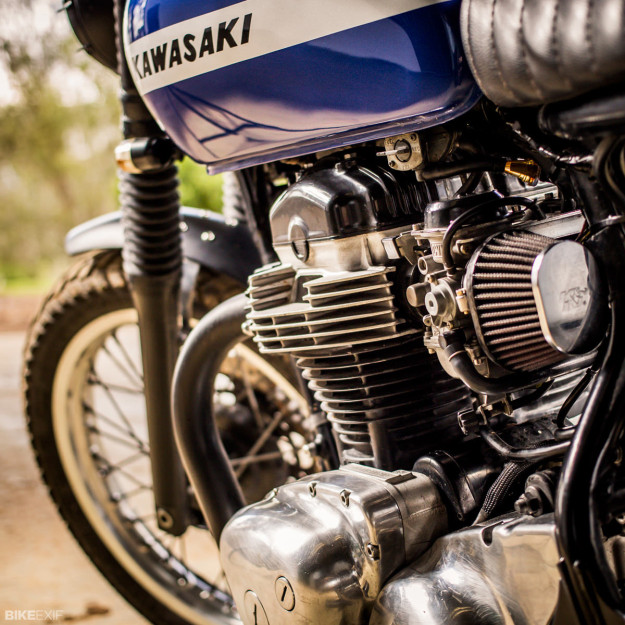
I also fitted the W800 exhaust headers, which have a bend that follows the lines of the frame much tighter than the 650 headers did. Alex then added kinks into the ends and installed a pair of Cone Engineering Quiet-er Core mufflers that I procured from Dime City Cycles. The whole system was then sent out for ceramic coating. I had originally considered high pipes, but ditched the idea for the sake of cost-saving and practicality.
I wanted to lose the W’s side covers and needed a new battery box, so Alex fabricated one from aluminum. It houses a Ballistic 8-cell Lithium-Ion battery and the wiring. The ignition was relocated to the side of the bike, and he machined out the space on the triple clamp where it used to be. That now houses a Daytona Velona speedo, bought from the Wrenchmonkees’ web store.
Another place where I wanted to shave some visual weight was the tank. This involved removing the rubber kneepads, cutting off their brackets and filling in the remaining grooves. The tank then had to be smoothed off and re-lined.

Aluminum fenders were sourced on eBay, before being shortened and fitted. (Ask Alex how long I deliberated over the rear fender’s length—you might get some choice words in reply.) Finishing kit included a smaller headlight and tail light from Kickstarter Classics, and a pair of light grey Biltwell Kung Fu grips from Old Skool Trading. We also fitted a pair of K&N filters, replacing the generic filters that I originally got with the bike.
Alex made a custom aluminum bash plate, and trimmed the W800 chain guard before sending it, and a bunch of other parts, off for powder coating. I swapped the old bars out for a new set of Renthal Enduro Highs—which have proved to be great for extra leverage and comfort. Not wanting everything on the bike to be brand new and shiny, I retained the stock switchgear and the bullet indicators that I already had.
Halfway through the project we decided to go the whole nine, so Alex tore down the whole bike and detabbed the frame. In the process, he made up a nifty bracket to hold the stock seat latch. It’s based on an idea that my wife penned, and will allow me to remove the factory setup if I ever want to use a custom seat in the future.
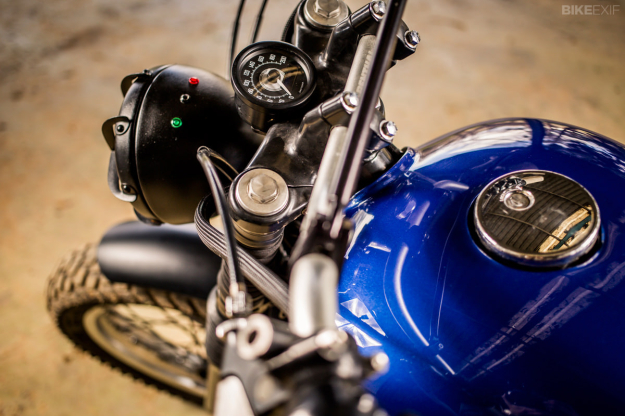
Alex also installed new neck bearings, chain and sprockets and swingarm bearings, and serviced the forks. Along the way he made a troubling discovery: someone that had handled the swingarm previously had dented it. After much heating, bending, pressing and cursing, he managed to get it sorted.
Donald Walklett at Motoworx then handled the electrics, trimming down the stock wiring harness a tad. He also rebuilt the carbs which, thanks to my neglect, ended up needing a significant amount of work.
The paint is probably the thing I deliberated on the most—I lost track of how many ideas I mocked up. In the end I opted for something simple and classic—a deep pearl blue with a silver stripe and hand-painted Kawasaki logos. It was flawlessly executed by Bert Upton, who also splashed some matte black onto the fenders for me.
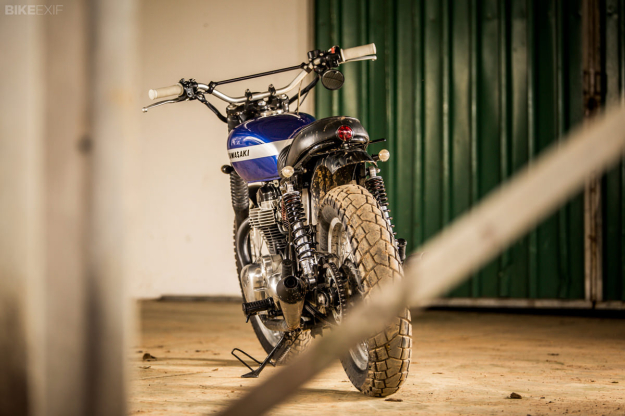
The valve cover and carb tops were sent off for powder coating, while the side covers were polished before being ‘Scotchbrited’. The plan was to powder coat the side covers too—but that would have meant replacing the oil sight glass, which would have to come from Japan. Anodizing the wheels would have strained the budget too much, so those were left stock.
In the end, everything came together just as I had envisioned it—so I really couldn’t be happier. Sure, there’s still work to be done—like replacing that spongy rear suspension—but eighteen months after parking it I’m finally enjoying my favorite bike again.
I’ve dubbed it the SC Rambler: SC as a nod to Stoos Customs for Alex’s excellent work, and Rambler because that’s what it’s used for.
And if you’re wondering what the tires are, they’re a Pirelli MT60 (front) and MT90 (rear). Still the same tires that carried me over Ouberg Pass.
All photos by Ewald Sadie.
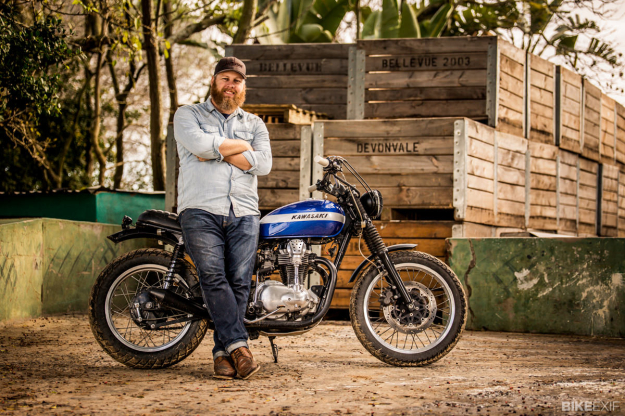
Many thanks to Dime City Cycles, Wrenchmonkees, Alex Stoos, Donald Walklett, Bert Upton, Ewald Sadie, Adventure Rider, Mike Hopkins Motorcycles, Craig’s Motorcycle Spares; Pedro at CRD and Fred at Blitz for their advice, Chris Hunter for the encouragement, and—of course—mom.